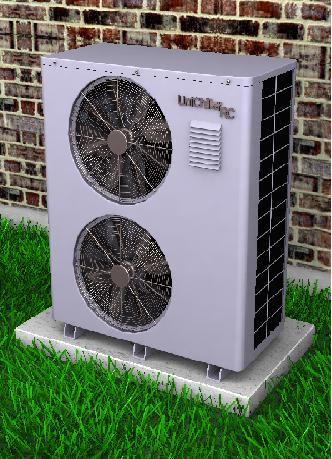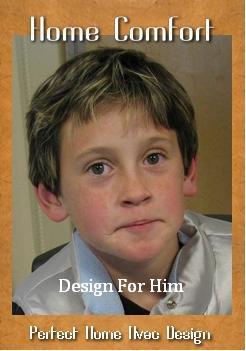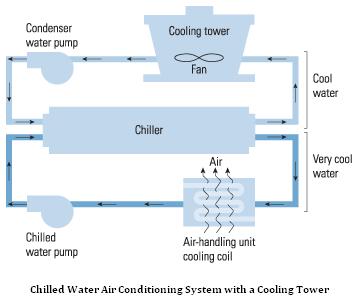RESIDENTIAL CHILLERS:
Another Cooling Option for Your Home

Chilled water air conditioning systems for the home are quite rare, although companies, such as Unico, are producing chilled water air conditioning systems for use in the home market.
Chilled water cooling is quite different from the typical freon-based residential air conditioner. In a conventional home air conditioner, refrigerant is circulated through a furnace with an evaporator coil or a coil equipped air handler to remove heat from the indoor air. The refrigeration lines connect the outdoor unit to the indoor unit, and the refrigerant (freon) makes the full loop between the two components.
In a chilled water air conditioning system, water does the chore of absorbing heat from inside and transfering that heat outside to be dispersed into the atmosphere.
Chilled water is cooled to between 40*F and 45°F and is circulated through a water coil equipped air handler, heat is absorbed from the air as the the air handler blower re-distributes the now cooler air back into the residence.
The water, which has absorbed heat from inside, is then pumped outside for heat removal. This process is continued until thermostat set-point is achieved.
A great benefit of a chilled water air conditioning system (chiller) is that the system is very forgiving, unlike a conventional central air conditioner. In a conventional system, zones cannot be too small, or enough air flow across the evaporator coil cannot be acieved, and the system freezes up. Not a problem with a chilled water system.
Providing the chilled water piping is insulated well, there is no practical limit to the length of the chilled-water piping. This has always been a problem of the conventional system. Once a conventional system's line set exceeds 75' in length, a certain amount of efficiency is lost, and could require special sizing and engineering to ensure proper function and limit equipment damage. Some manufacturer's warranties are void if the line set exceeds 100 feet.
Although chilled water air conditioning systems for the home are still relatively rare, their use is increasing. More and more homes are turning to this system to air condition their homes because of its cost-effectiveness and the less hazard of having refrigerant piping running through the house.
In the residential systems described earlier, air is used to dissipate the heat from the outside coil.
 Commercial units and cooling towers
Commercial units and cooling towers
Commercial applications, such as hotels, motels, condo projects, apartment complexes, factories, shopping malls, etc., are very common. Large areas or hundreds of rooms can be cooled individually. Each area can be equipped with it's own air distribution system, and fed by a single, or multiple, large chilled water systems.
The use of refrigerants is not completely eliminated by a chiller. Whether the unit is a 65-ton commercial unit or a 6-ton residential unit, the outdoor component still utilizes a freon loop, compressor, and heat exchanger to effectively remove heat from the water before the 45* water is sent back inside to remove more heat.
These commercial systems usually incorporate a roof mounted chiller with a cooling tower. This system effectively lowers the water temperature to about 45*F, before the cooled water is pumped back in to the individual distribution systems.

In large systems, efficiency can be improved significantly by incorporating a cooling tower. The cooling tower creates a stream of lower-temperature water. This water runs through a heat exchanger and cools the hot coils of the air conditioner unit.
Cooling towers come in many different shapes and sizes, but they all work on the same basic principles.
In many office complexes and college campuses, cooling towers and air conditioning equipment are centralized, and chilled water is routed to all of the buildings through miles of underground pipes.
Leave Chilled Water Air Conditioning and Return to HOME

Please feel free to link to this page from your website. This page's URL is: http://www.perfect-home-hvac-design.com/chilled-water-air-conditioning.html
Enjoy this page? Please pay it forward. Here's how...
Would you prefer to share this page with others by linking to it?
- Click on the HTML link code below.
- Copy and paste it, adding a note of your own, into your blog, a Web page, forums, a blog comment,
your Facebook account, or anywhere that someone would find this page valuable.






















